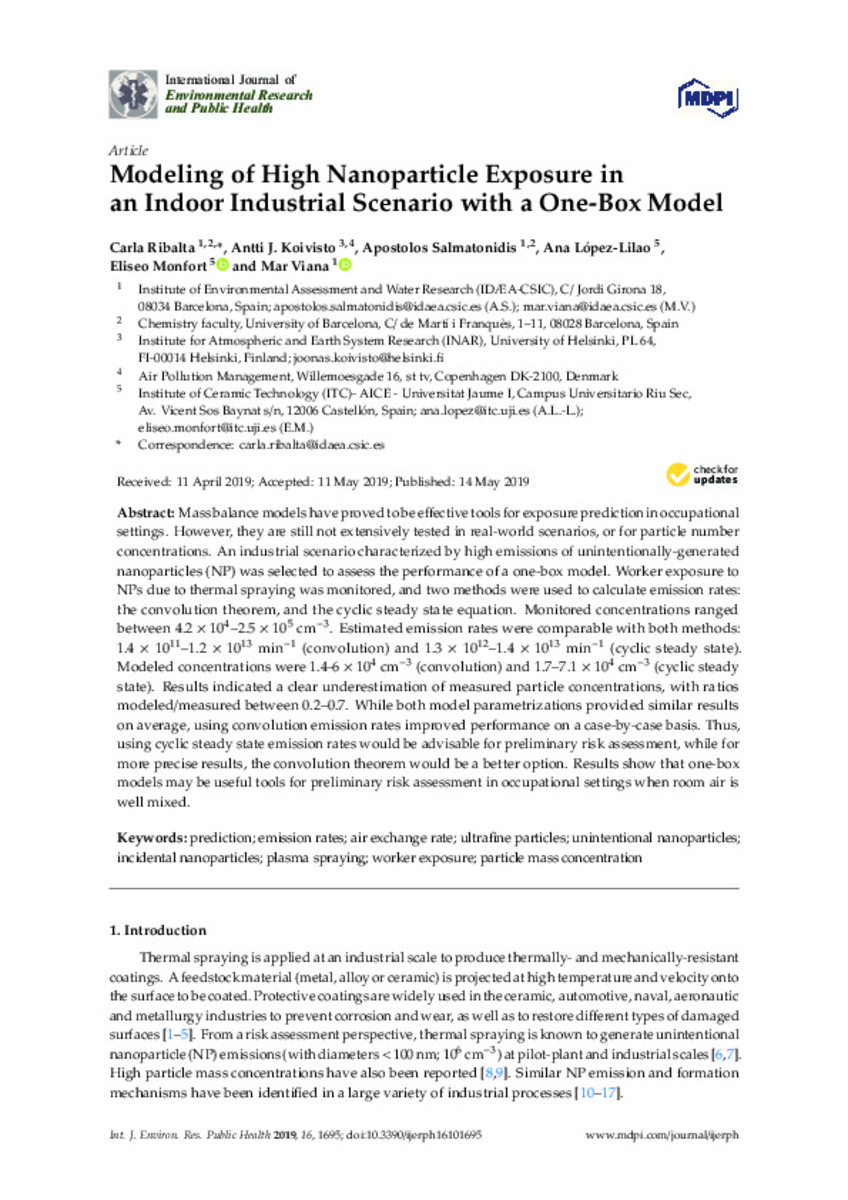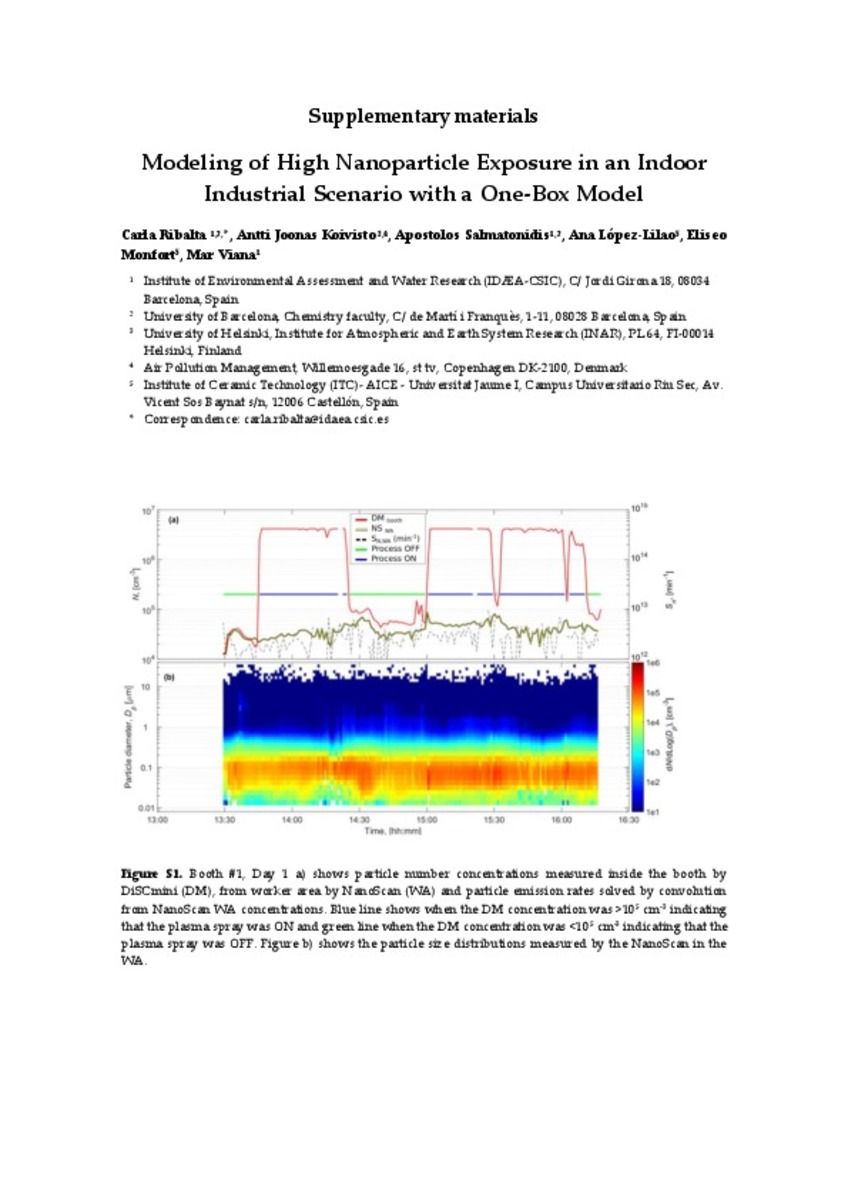Mostrar el registro sencillo del ítem
Modeling of High Nanoparticle Exposure in an Indoor Industrial Scenario with a One-Box Model
| dc.contributor.author | Ribalta, Carla | |
| dc.contributor.author | Koivisto, Antti Joonas | |
| dc.contributor.author | Salmatonidis, Apostolos | |
| dc.contributor.author | López Lilao, Ana | |
| dc.contributor.author | Monfort, Eliseo | |
| dc.contributor.author | Viana, Mar | |
| dc.date.accessioned | 2019-07-19T10:05:24Z | |
| dc.date.available | 2019-07-19T10:05:24Z | |
| dc.date.issued | 2019-05 | |
| dc.identifier.citation | RIBALTA, Carla, et al. Modeling of High Nanoparticle Exposure in an Indoor Industrial Scenario with a One-Box Model. International journal of environmental research and public health, 2019, 16.10: 1695. | ca_CA |
| dc.identifier.uri | http://hdl.handle.net/10234/183303 | |
| dc.description.abstract | Mass balance models have proved to be effective tools for exposure prediction in occupational settings. However, they are still not extensively tested in real-world scenarios, or for particle number concentrations. An industrial scenario characterized by high emissions of unintentionally-generated nanoparticles (NP) was selected to assess the performance of a one-box model. Worker exposure to NPs due to thermal spraying was monitored, and two methods were used to calculate emission rates: the convolution theorem, and the cyclic steady state equation. Monitored concentrations ranged between 4.2 × 104–2.5 × 105 cm−3. Estimated emission rates were comparable with both methods: 1.4 × 1011–1.2 × 1013 min−1 (convolution) and 1.3 × 1012–1.4 × 1013 min−1 (cyclic steady state). Modeled concentrations were 1.4-6 × 104 cm−3 (convolution) and 1.7–7.1 × 104 cm−3 (cyclic steady state). Results indicated a clear underestimation of measured particle concentrations, with ratios modeled/measured between 0.2–0.7. While both model parametrizations provided similar results on average, using convolution emission rates improved performance on a case-by-case basis. Thus, using cyclic steady state emission rates would be advisable for preliminary risk assessment, while for more precise results, the convolution theorem would be a better option. Results show that one-box models may be useful tools for preliminary risk assessment in occupational settings when room air is well mixed. | ca_CA |
| dc.format.extent | 16 p. | ca_CA |
| dc.format.mimetype | application/pdf | ca_CA |
| dc.language.iso | eng | ca_CA |
| dc.publisher | MDPI | ca_CA |
| dc.rights | © 2019 by the authors. Licensee MDPI, Basel, Switzerland. This article is an open access article distributed under the terms and conditions of the Creative Commons Attribution (CC BY) license (http://creativecommons.org/licenses/by/4.0/). | ca_CA |
| dc.rights | Atribución 4.0 Internacional | * |
| dc.rights.uri | http://creativecommons.org/licenses/by-sa/4.0/ | * |
| dc.subject | prediction | ca_CA |
| dc.subject | emission rates | ca_CA |
| dc.subject | air exchange rate | ca_CA |
| dc.subject | ultrafine particles | ca_CA |
| dc.subject | unintentional nanoparticles | ca_CA |
| dc.subject | incidental nanoparticles | ca_CA |
| dc.subject | plasma spraying | ca_CA |
| dc.subject | worker exposure | ca_CA |
| dc.subject | particle mass concentration | ca_CA |
| dc.title | Modeling of High Nanoparticle Exposure in an Indoor Industrial Scenario with a One-Box Model | ca_CA |
| dc.type | info:eu-repo/semantics/article | ca_CA |
| dc.identifier.doi | https://doi.org/10.3390/ijerph16101695 | |
| dc.relation.projectID | Spanish MINECO (CGL2015-66777-C2–1-R, 2-R), and through project PCIN-2015–173-C02-01, under the frame of SIINN, the ERA-NET for a Safe Implementation of Innovative Nanoscience and Nanotechnology, by SIINN-ERANET project CERASAFE (id.:16). Additional support was provided by Generalitat de Catalunya AGAUR 2017 SGR41, the Spanish Ministry of the Environment (13CAES006), FEDER (European Regional Development Fund) “Una manera de hacer Europa”. | ca_CA |
| dc.rights.accessRights | info:eu-repo/semantics/openAccess | ca_CA |
| dc.relation.publisherVersion | https://www.mdpi.com/1660-4601/16/10/1695/htm | ca_CA |
| dc.type.version | info:eu-repo/semantics/publishedVersion | ca_CA |
Ficheros en el ítem
Este ítem aparece en la(s) siguiente(s) colección(ones)
-
ITC_Articles [74]
Excepto si se señala otra cosa, la licencia del ítem se describe como: © 2019 by the authors. Licensee MDPI, Basel, Switzerland. This article is an open access article distributed under the terms and conditions of the Creative Commons Attribution (CC BY) license (http://creativecommons.org/licenses/by/4.0/).









